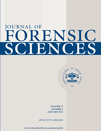Rapid In Situ Repeatable Analysis of Drugs in Powder Form Using Reflectance Near-Infrared Spectroscopy and Multivariate Calibration
Abstract
Abstract: This study takes the first step toward in situ analysis of powder drugs which does not require any alteration of the samples. A fast, inexpensive analytical method based on reflectance near-infrared (NIR) spectrometry and multivariate calibration was applied. A diode-array fiber-optic portable spectrometer in the 900–1700 nm range was employed. Samples were laboratory-prepared ternary powders (diacetylmorphine, caffeine, and paracetamol). Partial least squares regression was applied. The choice of the standard samples for calibration and validation was performed through a D-optimal experimental design. The explained variance was higher than 90%, and the relative root mean square errors were <2%. The number of principal components (6) was very low when compared with the number of raw variables (356 absorbance values). Response plots showed slopes and intercepts were very close to optimal values. Correlation coefficients ranged between 0.909 and 0.989. The method here proposed proved to be competitive with Fourier transform NIR spectrometry.




